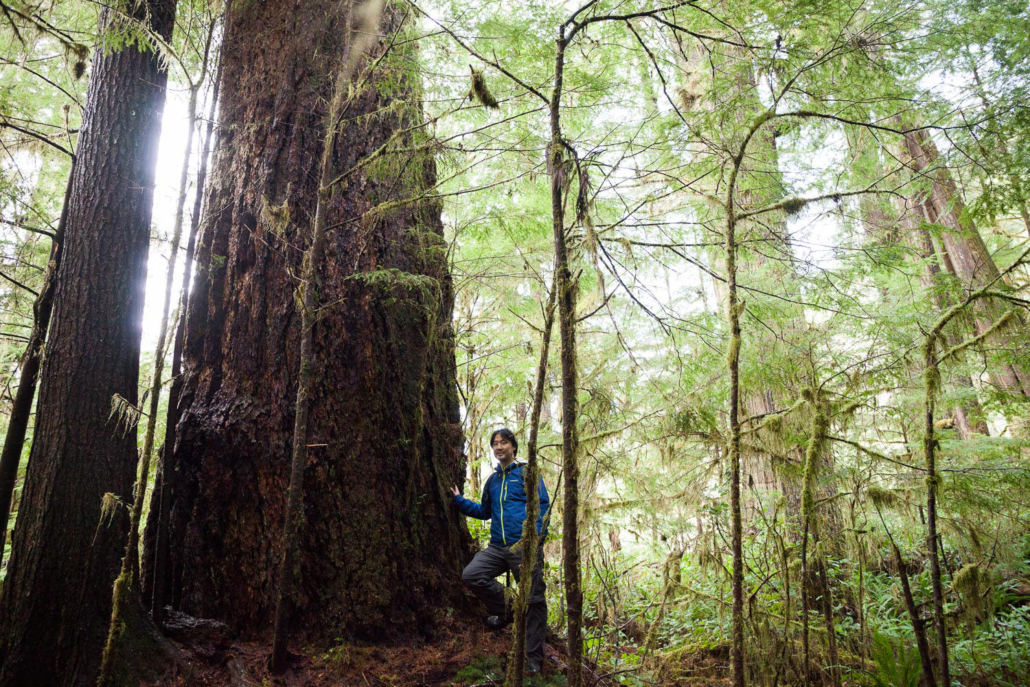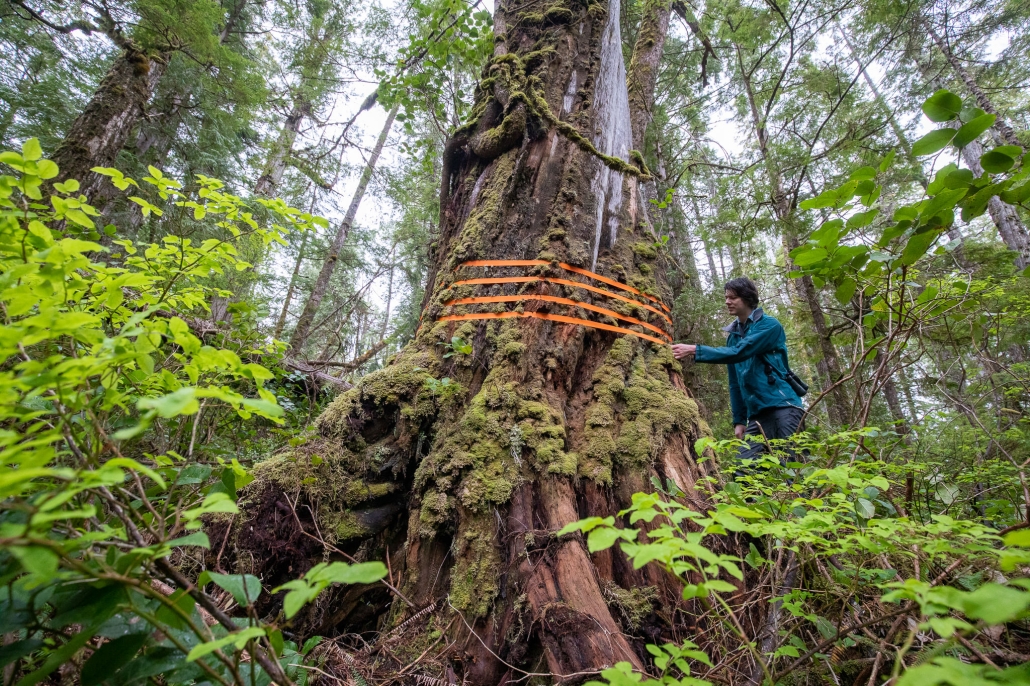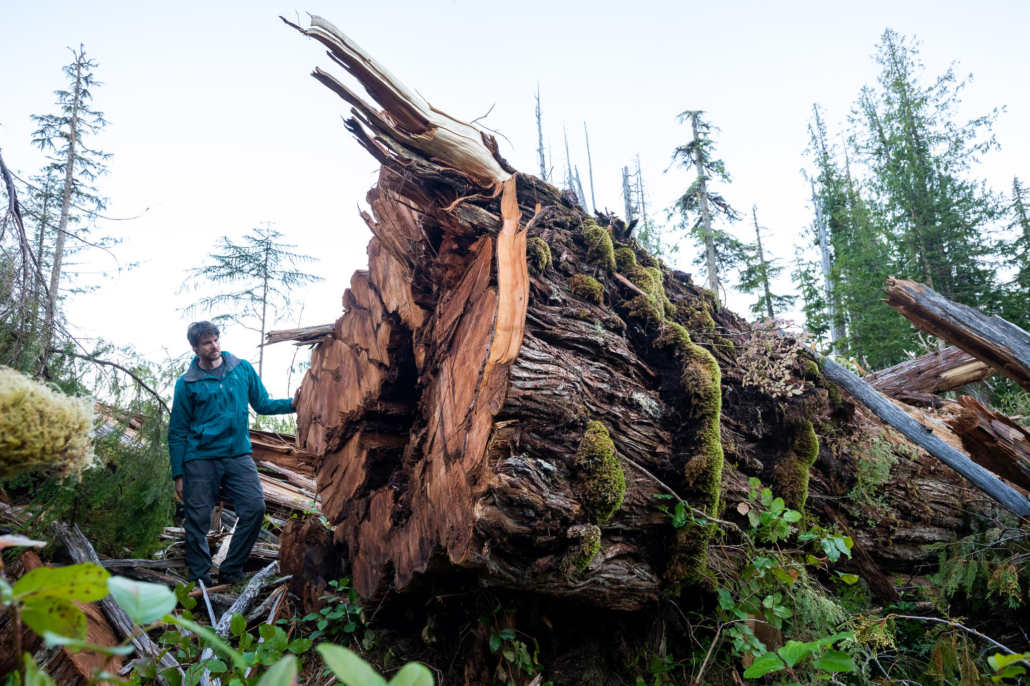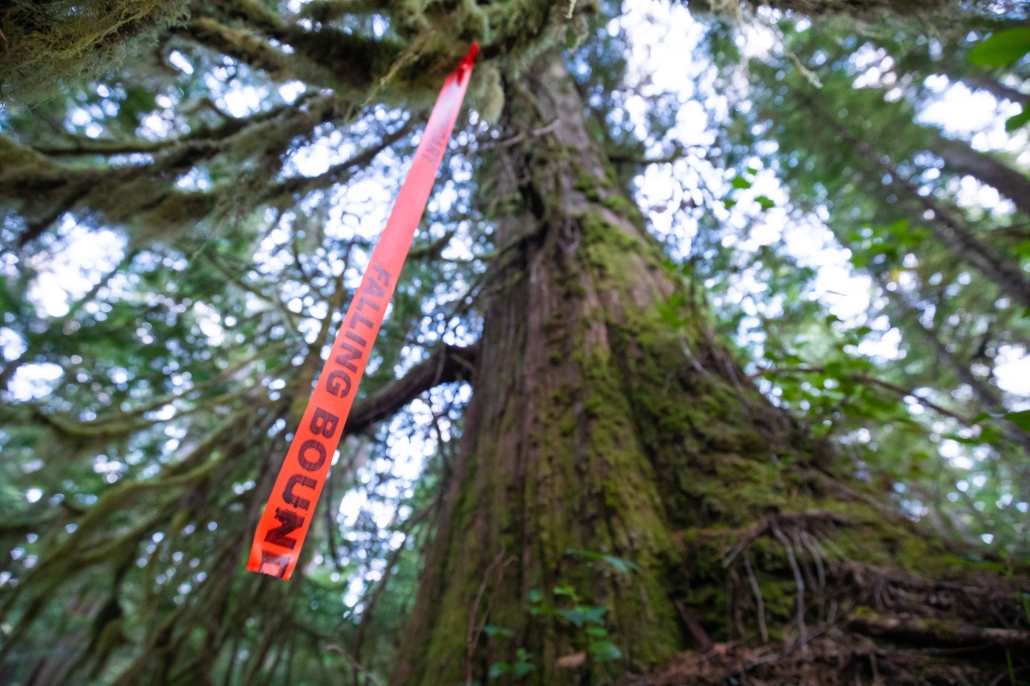 May 22 2024
May 22 2024BC Old-Growth Policy Update Adds Little To Current Commitments
Conservationists note the latest BC government plan doesn’t include much action beyond its previous commitments, with the updated plan lacking specificity and objectives around old-growth protection. Key deferral funding and ecosystem-based targets are still missing. However, the mention of a science advisory group is much welcomed. Existing commitments to protect 30% of BC by 2030 with over $1 billion in provincial-federal funding are moving protected areas progress forward, as the province has been in discussions with dozens of First Nations across BC on their Indigenous Protected and Conserved Areas (IPCA) proposals.
The BC government released an old-growth policy update yesterday outlining its roadmap for forest management and old-growth conservation in BC. The document titled “From Review to Action,” is the province’s official implementation plan thus far for the recommendations laid out by the Old Growth Strategic Review Panel (OGSR), which was tasked in 2020 to evaluate how old-growth forests are managed in BC.
The OGSR found that the status quo was ecologically and economically unsustainable and that a “paradigm shift” was urgently needed in forest management in BC, echoing what environmental groups had been arguing for decades. The BC government accepted all of the OGSR recommendations and pledged to implement them, representing a major shift from the government’s previous stances on the old-growth issue.
This plan builds on the steps already taken by the BC government including:
- A commitment to incrementally protect 30% of BC by 2030 (currently, 15% of BC is in legislated protected areas).
- Securing over $1 billion to enable this expansion, which includes a dedicated $300-million conservation financing fund and a joint $100 million+ in a federal/provincial old-growth conservation fund.
- Floating a promising draft Biodiversity and Ecosystem Health Framework (BEHF) that has the potential to direct protected areas establishment correctly via “ecosystem-based targets”, which would ensure that science-based targets span all ecosystems, including the most endangered and least represented ones.
- Establishing the Ministry of Water, Land, and Resource Stewardship (MWLRS) as a necessary coordinating agency in land and resource management.
- Supporting several Indigenous Protected and Conserved Areas (IPCA) plans, including the Ahousaht and Tla-o-qui-aht conservancies recently announced in Clayoquot Sound and protecting the Incomappleux Valley last year.
These historic milestones in old-growth conservation are significant and deserve to be celebrated. But conservationists are pointing out that critical gaps remain in government policy, that if not addressed will mean that the protection of the most at-risk old-growth ecosystems will fall short. Except for a promising mention that they will bring together a science advisory committee to help guide their forthcoming biodiversity-related policies, the newly released plan does not directly address the remaining policy gaps. The most important of these gaps include a lack of funding for First Nations’ lost revenues when they consent to old-growth logging deferrals (without such “solutions space” funding, the BC government won’t be able to secure logging deferrals on the full 2.6 million hectares of the most at-risk old-growth stands in BC – and they know this…) and the lack of ecosystem-based protection targets (protected areas targets for every ecosystem based on science and Traditional Ecological Knowledge that “aim” protection correctly to also include the most endangered ecosystems, like big-tree old-growth ecosystems, rather than skirting around them as is typically the case with government policies) which may yet come in via the Biodiversity and Ecosystem Health Framework due in 2025.
Despite these critical shortcomings in the BC government’s old-growth policies thus far, conservationists are drawing a sharp contrast between the positions of the NDP government and those of the ascendant BC Conservative Party, currently among the opposition parties. BC Conservative Party leader John Rustad recently stated that he would scrap BC’s 30% by 2030 protected areas commitment, making false claims that the commitment would result in 30% less agriculture and 30% less forestry in BC. The reality is that the protected areas expansion would happen almost exclusively on Crown/unceded First Nations lands where farming is already illegal (farming happens on private lands, and private lands are only purchased for conservation purposes from willing sellers and focused on native ecosystems, not farmlands). Forestry would not be reduced by anywhere close to 30% as the added protections would amount to 15% more protected areas at most (given that 15% of BC is already protected) and would include vast areas of alpine, subalpine, wetlands, grassland, bogs, lake and rivers without trees or timber value.
The BC Conservative’s platform states that forestry in BC is already “100% Sustainable” despite the independent findings of the OGSR that the massive clearcutting and old-growth liquidation that define current forest policy represent a model that is diametrically opposed to sustainability. The Conservative platform also pledges to mobilize the government to persecute activists (typically First Nations and environmentalists) who disrupt resource industries. In general, the Conservative platform promotes the classic destructive status quo economics of massive industrial resource depletion that has resulted throughout history in the collapse of both rural employment and ecosystems — think of the Atlantic cod fisheries or the 30-year decline of forestry in BC due to the massive overcutting of the valley bottoms and lower elevations where the biggest, best trees once stood, leaving behind smaller trees on steep slopes that are expensive to reach, resulting in mill closures — instead of the modernization of the BC economy towards smart, diversified, and sustainable industries and policies.

Endangered Ecosystem Alliance’s Ken Wu with a giant Douglas-fir tree in the unprotected Eden Grove near Port Renfrew in Pacheedaht territory.
Quotes:
Ken Wu – Executive Director, Endangered Ecosystems Alliance:
“The BC NDP government has objectively taken us farther along than any previous government in bringing the key policy pieces together needed to protect old-growth and endangered ecosystems. Under their leadership and First Nations, we are on the brink of the largest expansion of protected areas in BC’s history as dozens of Indigenous Protected and Conserved Area plans are now underway. However, they are still missing several critical policies, the most important of which is the lack of ecosystem-based protection targets — because just one province-wide target is insufficient to capture all ecosystems and will potentially allow new protected areas to skirt around the many productive forests with the biggest trees — based on science and Traditional Ecological Knowledge. They also have thus far failed to allocate the needed funding to cover the lost forestry revenues of First Nations if they agree to implement old-growth logging deferrals – hence resulting in only half of the priority, most at-risk old-growth being deferred from logging — a frustrating and consistent failing on the BC NDP government’s shoulders for which they deserve full blame and that they must remedy ASAP.
Right now, the rise in the polls of the BC Conservative Party with their extremist anti-environmental stance to kill BC’s protected areas commitment and who state against all evidence that ‘forestry in BC is already 100% sustainable’, is undoubtedly creating great caution within the BC NDP government against moving forward quickly with ambitious environmental action. It is essential for BC environmentalists to expose and tackle the giant Conservative cave troll in the room – Rustad’s radical anti-environmental agenda- as in 5 months they may be ruling the province and undertaking a backwards reversal to 1980’s resource policies that kill most of the forthcoming protected areas expansion, as is their plan.
The old-growth update released by the Ministry of Forests yesterday is a fairly lacklustre plan with few objectives and little action. It’s mostly about processes regarding shared decision-making with First Nations and more planning tables. The one bright light is the mention of an expert advisory panel to implement biodiversity-related measures — a much-needed and welcome precursor to potential ecosystem-based targets. The actual action from the BC government has been largely outside the Ministry of Forests, via the new Ministry of Water, Lands and Resource Stewardship which has been mandated to protect 30% of the province’s land area by 2030, is in charge of over $1 billion in provincial-federal funding to make it happen, and is now moving forward with discussions on dozens of Indigenous Protected and Conserved Areas (IPCA) projects of First Nations across BC, totalling millions of hectares that will help protect ecosystems and indigenous cultures.
My overall assessment of Eby and old growth is that he has taken unprecedented leaps forward in developing the enabling policies to expand protected areas in BC via First Nations, which is how protected areas are now done in BC, and he should be thanked for this — but there are still critical gaps in conservation policies that have to be fixed. Eby needs to show leadership and get this done.”
TJ Watt – Photographer & Campaigner, Ancient Forest Alliance:
“The BC government’s latest old-growth update notes some significant strides that have been made toward enacting a paradigm shift in the conservation and management of forests in BC, however, it lacks specificity and objectives on the action front – namely, how the government will address the fact that thousand-year-old trees with trunks the size of living rooms are still being cut down today. British Columbians are rightfully angry and dismayed by the fact that they still must advocate for this destructive practice to stop. Ecological emergencies such as the biodiversity and climate crisis that old-growth logging massively contribute to call for a modern version of wartime efforts. The BC government must show leadership and pull out all stops to remove well-known barriers to old-growth protection such as providing at least $100 million in deferral or ‘solutions space’ funding and ensuring that new protected areas are aimed at preserving the most at-risk areas through ecosystem-based targets. This calls on them to become true advocates for protecting the best old-growth forests instead of being content with landing only part-way there.”
Ian Thomas – Research & Engagement Officer, Ancient Forest Alliance:
“We are heartened by the progress made by the provincial government on conservation financing and their commitments to vastly expand protected areas. But without directing that funding towards the most threatened old-growth ecosystems we will continue to lose large tracts of our most magnificent ancient forests. This plan was a missed opportunity to identify the gaps and own up to the stalled progress on TAP deferrals. The actual results of this ongoing refusal to tackle this issue will be the loss of irreplaceable forests and the further degradation of threatened biodiversity in BC. The NDP can and must do better to ensure the TAP deferrals are implemented in their entirety, and ecosystem-based protection targets guide land-use decisions across the province, but let’s not kid ourselves and assume the NDP’s failures are remotely comparable to the stated goals of the BC Conservatives. The Conservative platform is quite simply terrifying. We are in an ecological catastrophe with compounding biodiversity and climate crises that threaten human well-being on an unprecedented scale. The NDP government, despite moving far too slowly in many ways, has at least accepted that we are at a moment when the ship needs to be swerved away from the iceberg. The Conservative platform is about aiming right at the iceberg and leaning on the throttle. The wildfire crisis bearing down on the province this summer is a result (globally and locally) of the same destructive policies of unsustainable resource extraction that John Rustad is promising to intensify. Furthermore, Rustad has pledged to use the legal system to target, intimidate and persecute anyone who threatens the profits of resource corporations, pledging to side with large corporate development over the voices of local community members. The environmental movement needs to hold the NDP to account for their failings, but also not make a false equivalency between current policy and the extreme anti-environmental agenda that the conservatives are promising to implement.”

Ancient Forest Alliance’s Ian Thomas beside an old-growth cedar in a forest under imminent threat on northern Vancouver Island in Quatsino territory.
More information:
Our main concerns with regards to the BC government’s latest old-growth update include:
- There is little mention of old-growth protection and no mention of ecosystem-based targets. It mainly hides behind better consultations and forest planning tables but lacks many actual objectives. The beginning of the document does mention the importance of the BC Nature Agreement and the BC Conservation Financing mechanism, both funds that are designed to expand the protected areas system – but then doesn’t incorporate them in the body of their old-growth policies.
- The Ministry of Forests has failed to secure old-growth logging deferrals for half of the priority most at-risk Technical Advisory Panel old-growth categories (i.e. 1.3 million of the 2.6 million hectares are secured). There is no great mystery why this is so – the BC government has still yet to provide deferral or “solutions space” funding for the lost revenues of First Nations who have an economic dependency on old-growth logging and who are contemplating deferrals but who have not committed yet to IPCAs. This has been an ever-present failing of this government and we emphasize the importance of deferral or “solutions space” funding.
- There is no BC Protected Areas Strategy (unlike with the NDP government in the 1990s) to develop plans, centralize resources, undertake needed assessments like gap analyses, and systematically prioritize areas via science-based targets. The current approach is ad hoc based on a first-come, first-serve scenario from First Nations who have previously developed IPCA proposals largely driven by previous federal funding.
- The local Forest Landscape Planning tables can include the establishment of new protected areas, but it certainly isn’t being emphasized by the Ministry of Forests. There is no substitute for a coordinated provincial strategy to get to 30% by 2030 entailing ecosystem-based targets.
- The Biodiversity and Ecosystem Health Framework (BEHF) when implemented could create the targets needed to guide new protected areas expansion (e.g. Provincial Conservancies and Parks) — as it must — but the response of the civil servants, when questioned, seems to indicate it will more likely just update targets for the weaker Biodiversity Guidebook conservation reserve system. i.e. It will only guide the weaker and smaller old-growth reserves in the “working landscape” like Old-Growth Management Areas and Wildlife Habitat Areas — both of which are tenuous designations full of logging loopholes — but not necessarily the major protected areas system like Conservancies and Parks. Instead, the protected areas with strong protections need to aim for the “good stuff” too and not largely emphasize alpine and subalpine landscapes. Strong ecosystem-based targets from the BEHF that form the foundation of a BC Protected Areas Strategy and that guide the expenditure of the BC Nature Agreement and Conservation Financing funds, in terms of priority areas and expenditures, are vital. Otherwise, BC will end up with a protected areas system that still largely skirts around the valley bottoms and emphasizes protecting a lot of alpine and subalpine areas of low timber values.
- We have concerns that the timber industry may be involved in creating the conservation targets of the Biodiversity and Ecosystem Health Framework – this is an absolute no-go for conservation. Independent science and Traditional Ecological Knowledge committees, similar to the Coast Information Team struck up during the Great Bear Rainforest process, are needed, and the proposed BC Biodiversity Office would be the natural one to convene such a panel of experts in consultation with First Nations. We are concerned that no funding is provided to First Nations in the Forest Landscape Planning tables to establish conservation areas like Old-Growth Management Areas, Ungulate Winter Ranges, Wildlife Habitat Areas, etc. The funding thus far is only where First Nations want to create IPCAs. Without funding directed to First Nations right now for old-growth conservation at the FLP tables, these FLP tables may end up “baking in” forestry plans that are pre-paradigm shift — and this is what the MoF seems to be aiming for.
- The MoF has stated that they will be reviewing OGMA rules — and we hope it means that boundaries cannot be changed to allow logging of choice stands.
- The BC government currently only allows for incorrectly identified at-risk old-growth forests to be subtracted from rather than added to the priority TAP logging deferral areas. This constitutes a significant timber bias and conservation loophole that must be closed.
- Most importantly, the Biodiversity and Ecosystem Health Framework (BEHF) due in early 2025 will need to devise ecosystem-based targets that are:
• Legally binding and not merely aspirational guidelines.
• Guide the expansion of both the protected areas system like Provincial Conservancies and Parks and the biodiversity/conservation reserve system like OGMAs.
• Are fine filter enough to represent all BEC zones, subzones, variants, ecological communities, and, most critically, *Forest Productivity Distinctions* (i.e. areas that grow large vs medium vs small trees).
• Scale-up protection by incorporating the latest conservation biology science, based on independent scientists and Traditional Ecological Knowledge holders, not industry reps.

Ancient Forest Alliance’s Ian Thomas beside an ancient redcedar tree felled in 2022 on northern Vancouver Island in Quatsino territory.
See our information explaining the central importance of ecosystem-based targets and forest productivity distinctions.
In short, we believe what is needed is:
- An action plan that brings a goal of old-growth protection as the first cornerstone of old-growth management, both in terms of the real protected areas and biodiversity conservation reserves. It should emphasize the centrality of the BC Nature Agreement, BC Old-Growth Fund, and Conservation Financing mechanism to achieve these goals in its policies.
- A commitment to ecosystem-based targets to guide protected areas, conservation areas, and resource decisions – all based on independent science teams and Traditional Ecological Knowledge without industry.
- Recognizing the importance of forest productivity distinctions in protection and conservation targets.
- Developing a BC Protected Areas Strategy like the NDP of the 1990s to develop targets, analyses, and plans and to deploy resources and action to systematically expand the protected areas system based on science and Traditional Ecological Knowledge.
- A clear statement that the province still has a goal of achieving deferrals on the 2.6 million hectares of the TAP priority most-at-risk recommended deferral old-growth areas.
- Allocating deferral or “solutions space” funding for First Nations to implement deferrals even where they haven’t decided on IPCAs.
- Allocating funding for First Nations at the Forest Landscape Planning tables for potential lost revenues should they move forward with conservation reserves like OGMAs, WHAs, and UWRs.
- Moving to close the loopholes in OGMAs that allow moveable boundaries to enable logging and in WHAs and other such conservation designations that allow logging to take place.
- Ensure the addition of misidentified at-risk old-growth forests to the priority list of deferrals where identified by scientists, citizens, and industry.






